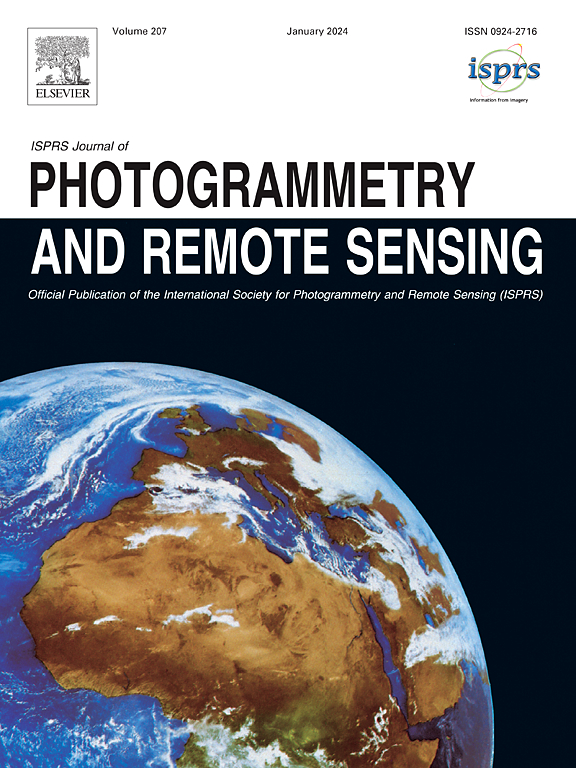FengYun-3 meteorological satellites’ microwave radiation Imagers enhance land surface temperature measurements across the diurnal cycle
IF 12.2
1区 地球科学
Q1 GEOGRAPHY, PHYSICAL
ISPRS Journal of Photogrammetry and Remote Sensing
Pub Date : 2025-03-06
DOI:10.1016/j.isprsjprs.2025.02.018
引用次数: 0
Abstract
Land Surface Temperature (LST) is a vital meteorological variable for assessing hydrological, ecological, and climatological dynamics, as well as energy exchanges at the land–atmosphere interface. Accurate and frequent LST measurement is essential for meteorological satellites. However, existing retrieval algorithms often fail to capture the nuances of diurnal temperature variations. This study utilizes the exceptional diurnal sampling capabilities of the Microwave Radiation Imagers (MWRI) on China’s FengYun-3 (FY-3) satellites to improve LST measurements throughout the day. The objective is to develop a global algorithm that can distinguish between frozen and thawed states of near-surface landscape. This algorithm integrates multi-channel brightness temperature data and an array of microwave indices to enhance accuracy across diverse land cover types. Validation against in-situ measurements, alongside the comparative analysis with ERA5 and MODIS LST products demonstrate the algorithm’s high robustness. Results reveal a correlation coefficient exceeding 0.87 between FY-3 MWRI-derived LST and 5-cm soil temperature, with a root mean squared error (RMSE) near 4 K, except at 14:00 for FY-3D. The theoretical uncertainty, estimated using triple collocation analysis of the three LST datasets from FY-3 MWRI, ERA5 and MODIS, is less than 4 K for the majority of the globe. Additionally, the FY-3 MWRI exhibits reduced diurnal variation in LST as compared to MODIS LST, the peak temperatures recorded by FY-3 MWRI occur with a certain time lag relative to MODIS, and the diurnal temperature range is generally narrower, showcasing its adeptness in delineating diurnal temperature cycles when deployed across the FY-3B/C/D satellite constellation.
风云三号气象卫星的微波辐射成像仪增强了整个日周期的地表温度测量
地表温度(LST)是评估水文、生态和气候动力学以及陆地-大气界面能量交换的重要气象变量。准确和频繁的地表温度测量对气象卫星至关重要。然而,现有的检索算法往往不能捕捉到日温度变化的细微差别。本研究利用中国风云三号(FY-3)卫星上的微波辐射成像仪(MWRI)的特殊日采样能力来改进全天的地表温度测量。目标是开发一种能够区分近地表景观冻结和解冻状态的全局算法。该算法集成了多通道亮度温度数据和一系列微波指数,以提高不同土地覆盖类型的精度。通过与ERA5和MODIS LST产品的对比分析,验证了该算法的鲁棒性。结果表明,FY-3 mwri反演的地表温度与5 cm土壤温度的相关系数超过0.87,除FY-3D在14:00时外,其余均误差(RMSE)在4 K附近。利用来自FY-3 MWRI、ERA5和MODIS的三个LST数据集的三重配置分析估计的理论不确定性在全球大部分地区小于4 K。此外,与MODIS LST相比,风云3 MWRI记录的地表温度的日变化较小,相对于MODIS,风云3 MWRI记录的峰值温度出现一定的时间滞后,且日温度范围普遍较窄,在整个风云3b /C/D卫星星座中部署时,显示出它在描绘地表温度日周期方面的能力。
本文章由计算机程序翻译,如有差异,请以英文原文为准。
求助全文
约1分钟内获得全文
求助全文
来源期刊

ISPRS Journal of Photogrammetry and Remote Sensing
工程技术-成像科学与照相技术
CiteScore
21.00
自引率
6.30%
发文量
273
审稿时长
40 days
期刊介绍:
The ISPRS Journal of Photogrammetry and Remote Sensing (P&RS) serves as the official journal of the International Society for Photogrammetry and Remote Sensing (ISPRS). It acts as a platform for scientists and professionals worldwide who are involved in various disciplines that utilize photogrammetry, remote sensing, spatial information systems, computer vision, and related fields. The journal aims to facilitate communication and dissemination of advancements in these disciplines, while also acting as a comprehensive source of reference and archive.
P&RS endeavors to publish high-quality, peer-reviewed research papers that are preferably original and have not been published before. These papers can cover scientific/research, technological development, or application/practical aspects. Additionally, the journal welcomes papers that are based on presentations from ISPRS meetings, as long as they are considered significant contributions to the aforementioned fields.
In particular, P&RS encourages the submission of papers that are of broad scientific interest, showcase innovative applications (especially in emerging fields), have an interdisciplinary focus, discuss topics that have received limited attention in P&RS or related journals, or explore new directions in scientific or professional realms. It is preferred that theoretical papers include practical applications, while papers focusing on systems and applications should include a theoretical background.
 求助内容:
求助内容: 应助结果提醒方式:
应助结果提醒方式:


